10 Types of Blackbirds in Australia (With Pictures)
Last Updated on
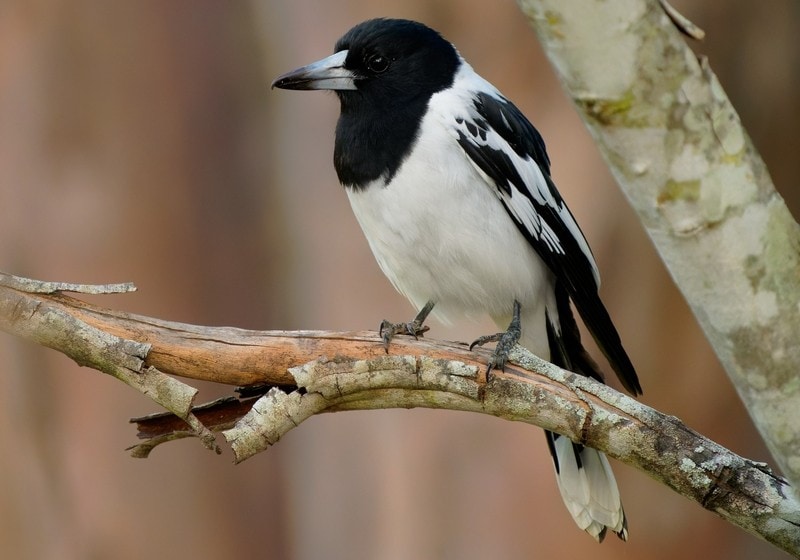
When people hear “black bird,” many automatically assume something like a raven or a crow. While these are definitely black birds, the name doesn’t necessarily mean they have to be jet black. Some of these birds have the most incredible undertones and colors within the black.
You may associate Australia with things that can hurt us, like giant spiders and snakes. And you wouldn’t be wrong, but instead of focusing on those things, let’s look at 10 types of black birds you can find in Australia.

The 10 Types of Blackbirds in Australia
1. Black-backed Magpie

| Scientific Name: | Tibicen |
| Primary colors: | Black and white |
| Wingspan: | 65 – 85 centimeters (cm) |
The black-backed magpie, a subspecies of the Australian magpie, is one of the continent’s greatest songbirds. They have several different songs that they can sing, some of them ranging up and down four octaves.
These magpies have glossy, black heads, wings, and underparts. Their white shoulders contrast this. The young birds typically have bright yellow eyes that become faded red as they mature.
2. Western Magpie
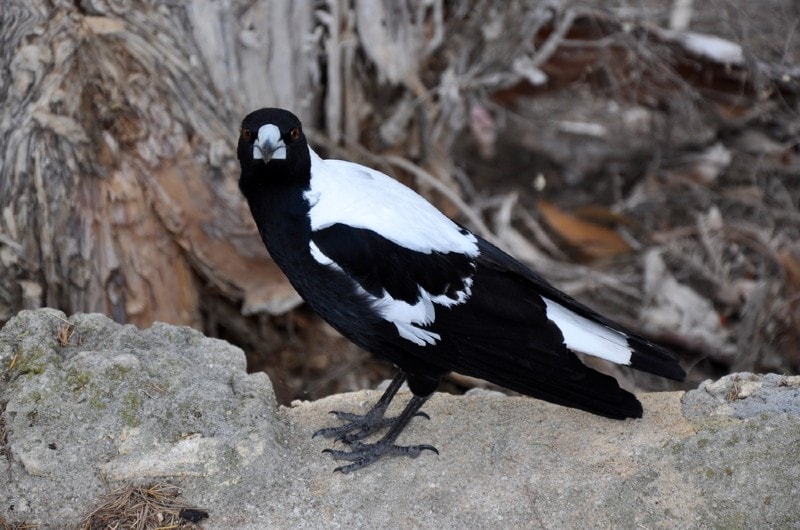
| Scientific Name: | Tibicen dorsalis |
| Primary colors: | Black and white |
| Wingspan: | 65 – 85 cm |
The western magpie is another subspecies of Australian magpies. One thing that separates this magpie apart from its other subspecies is the brilliant white beak that females have. Other than that, they have very similar coloring to the black-backed magpie. One difference is their back and nape are entirely white instead of having a black saddle on their white nape like the black-backed subspecies.
3. Pied Currawong
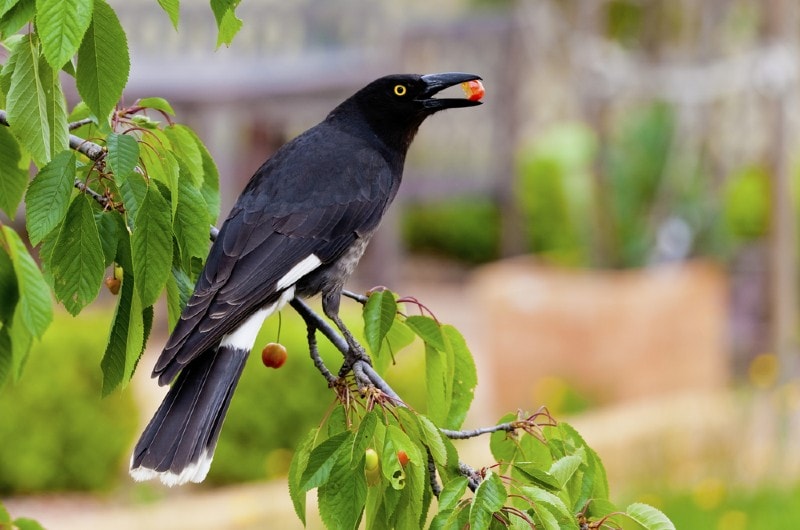
| Scientific Name: | Strepera graculina |
| Primary colors: | Black |
| Wingspan: | 56 – 77 cm |
For the most part, the pied currawong is entirely black except for some white under their wings and their tails—at the base and the tip. They have exceptionally long, hooked beaks that are longer than their heads. Young pied currawongs have similar markings to adults, but their underparts have more brown plumage.
These black birds are very vocal and have several different calls. You’ll usually hear them throughout the day. Still, they are typically more vocal in the mornings and the evenings before they roost for the night. Before a rainfall, they often get loud too.
4. Gray Currawong
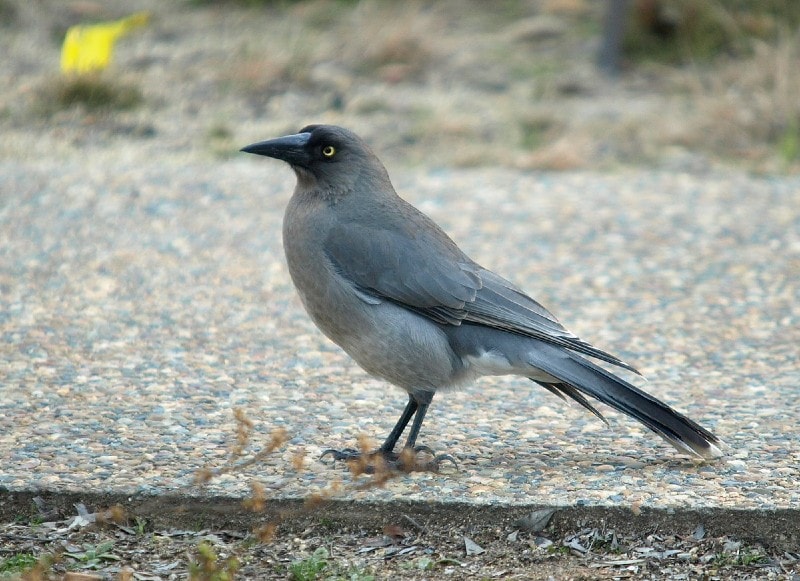
| Scientific Name: | Strepera versicolor |
| Primary colors: | Gray or black |
| Wingspan: | 72 – 85 cm |
The gray currawong is a close relative of the pied currawong, but it’s larger and more slender. Typically, the sizes overlap between males and females, but males are often on the larger end of the scale.
A gray currawong is typically a slate gray color as opposed to black. However, their eye rings, feet, and legs are black. In addition to black and gray, these birds usually have a white patch on their wing that varies in size between birds.
5. Pied Butcherbird

| Scientific Name: | Cracticus nigrogularis |
| Primary colors: | White and black |
| Wingspan: | 51 cm |
The pied butcherbird is an Australian native found almost everywhere on the continent. They are stocky birds with short legs. These birds are almost entirely black and white, with little variances between males and females. And unlike many other black birds, these have a healthy dose of white throughout their plumage.
Their incredible songs are what make this bird stand out. Occasionally a pied butcherbird will sing on a bright, moonlit night. However, they sing almost exclusively in the mornings. An interesting thing about their sounds is that they try to mimic sounds they hear, like other birds, dogs barking, and even people whistling.
6. Gray Butcherbird
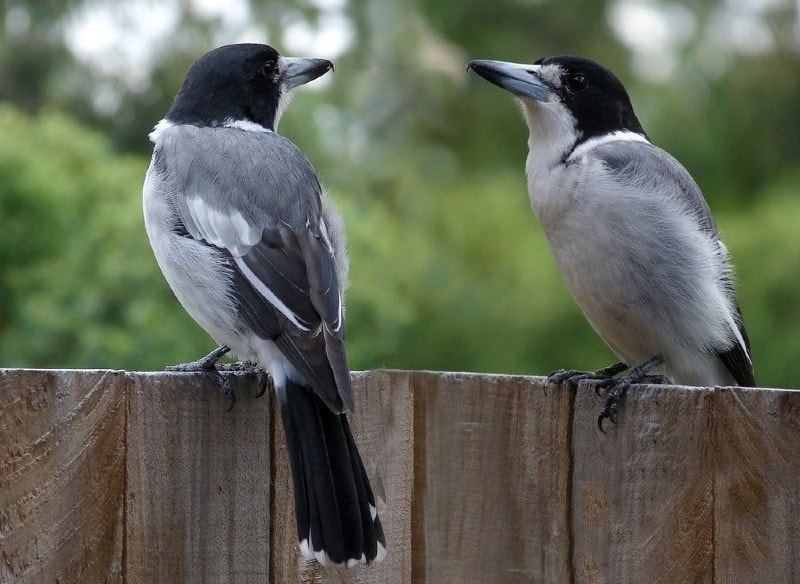
| Scientific Name: | Cracticus torquatus |
| Primary colors: | Gray, black, and white |
| Wingspan: | 37 – 43 cm |
The gray butcherbird is usually quite smaller than its other butcherbird relatives, and their coloration is also significantly different. This bird is a mixture of black, white, and gray. Their head is black, along with the tips of their tails. Then they have a white throat and white stripes at the base of their tail. Other than that, they are mostly a mixture of different shades of gray.
One difference that young gray butcherbirds have from the adults is the black head. Instead, it’s dark brown. In addition, they have dark-brown streaks through their body and an off-white throat.
7. Australian Raven

| Scientific Name: | Corvus coronoides |
| Primary colors: | Black |
| Wingspan: | 100 cm |
When we think of a “black bird,” this is the type of bird that comes to mind. A jet-black colored bird with white eyes. Interestingly, even though these birds appear solid black, their base feathers are gray or white, depending on the particular sub-species.
Another interesting tidbit is that their eyes change throughout their life. As young ravens, they have dark eyes. Over time, the iris lightens until it’s white with a blue ring.
8. White-winged Chough

| Scientific Name: | Corcorax melanorhamphos |
| Primary colors: | Black |
| Wingspan: | 44 – 50 cm |
The white-winged chough is similar to the Australian raven being predominantly black. A Major difference between the two is that the chough has a white under their wings, and their beak is longer and hooked. Plus, their eyes are reddish-orange instead of white.
As young birds, the white-winged chough is more of a brownish black, and they’re more fluffy. As they age, their tails grow long, their eyes turn red, and their plumage turns glossy black.
9. Apostlebird

| Scientific Name: | Struthidea cinerea |
| Primary colors: | Gray and black |
| Wingspan: | 32 – 36 cm |
Typically, apostlebirds flock in groups of 12, hence them being named after the 12 Apostles who followed Jesus Christ around and studied under him. Apostlebirds are also commonly referred to as gray jumpers.
For the most part, these birds are dark, slate gray. However, sometimes they have a slight greenish tint when the sun hits their plumage just right. Unfortunately, in some states within Australia, these birds are listed as threatened. Although, the Australian Environment Protection and Biodiversity Conservation Act 1999 does not recognize them as threatened yet.
10. Magpie-lark

| Scientific Name: | Grallina cyanoleuca |
| Primary colors: | Black and white |
| Wingspan: | 25 – 30 cm |
These small to medium-sized birds are also known as wee magpies sometimes. They are comparable in size to the common European blackbird. Male and female magpie-larks have similar colorations in black and white. The easiest way to tell them apart is that the males have a black throat and a white stripe for an eyebrow, and the females have white throats.
One interesting fact about the magpie-lark is that they are one of around 200 species of birds that sing in a duet. Each bird will sing alternating notes half a second apart. So, it can be tough to tell if it’s one or two birds singing.

Conclusion
Blackbird is a generic term that refers to many species of birds. Of all the bird species in Australia, this is pretty well all the “blackbirds.” Suppose you’re interested in finding these birds in their natural habitat. In that case, you’ll be happy to know that most of these birds are spread pretty much throughout Australia and New Zealand.
Featured Image Credit: Martin Pelanek, Shutterstock
About the Author Shea Cummings
Shea Cummings is a passionate content writer who believes that the power of words is immeasurable. He leverages years of experience in various trades such as carpentry, photography, and electrical to bring his articles to life. His goal is to provide his readers with information that delights and informs. When he's not writing you can find him spending time in the outdoors or playing some Minecraft on the Xbox with his wife and two sons.
Related Articles:
Monocular vs Telescope: Differences Explained (With Pictures)
10 Types of Hummingbirds in Arkansas (With Pictures)
8 Types of Hummingbirds in Nebraska (With Pictures)
5 Types of Hummingbirds in Idaho (With Pictures)
3 Types of Hummingbirds in Mississippi (With Pictures)
8 Types of Hummingbirds in Kansas (With Pictures)
5 Types of Hummingbirds in West Virginia (With Pictures)
5 Types of Hummingbirds in Ohio (With Pictures)
